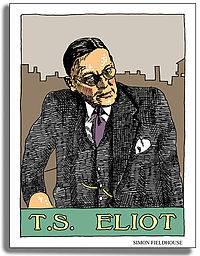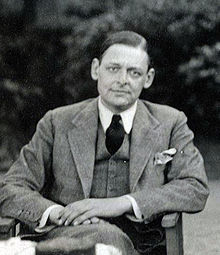When Up is Down (Part 1)
By Asher Crispe: June 25, 2012: Category Inspirations, Thought Figures
Kabbalistic Reflections on T.S. Eliot’s Four Quartets
General Introduction
 The quest of meaning has never been an easy one. The poet within us, as well as the poet laureate, suspect that meaning exists at the limits of language in a place so remote that it can only be accessed via a circuitous path. While our pre-linguistic intuition may afford us the ability to vault over this distance with the achievement of sudden illumination, our capacity for finding the right words may not be so travel worthy. We may fly to an experience at the price of having to relinquish our tools for describing it at the departure gate. And like a deplaning passenger, we may arrive before our baggage.
The quest of meaning has never been an easy one. The poet within us, as well as the poet laureate, suspect that meaning exists at the limits of language in a place so remote that it can only be accessed via a circuitous path. While our pre-linguistic intuition may afford us the ability to vault over this distance with the achievement of sudden illumination, our capacity for finding the right words may not be so travel worthy. We may fly to an experience at the price of having to relinquish our tools for describing it at the departure gate. And like a deplaning passenger, we may arrive before our baggage.
Perhaps the Talmudic tale of R’ Yehoshua ben Chananiah [Eruvin 53a], popularized and expounded upon in the Tanya of R’ Shneur Zalman of Liadi (1745-1812), can shed some light. To paraphrase the story: the sage recounts how how he came upon a child at the fork in the road as he was on his way to a certain city. He asked the child the way to the city to which the child responded: “This way is short and long, and that way is long and short.” The rabbi opts for the shorter longer way and in no time catches sight of the city but then stops short. His path is blocked. The final approach is a tangled thicket of gardens and orchards that halt his advance and ultimately proves untraversable. He then retraces his steps and address the child once more: “Didn’t you tell me that this is the short way?” to which the child responds: “Did I not [also] tell you that it is long?”
We often want the easy route in life, one that grants us immediate access to our intended destinations. Of all the places we go, the itinerary of concepts explored in an existential stroll down a metaphysical lane proves to be an arduous task. In the end all attempts to find short cuts fall short. We have to commit for the long haul for once we do the road clears, we gather momentum and may even enjoy our striving.
In Kabbalah, in the tradition of Sefer Yetzirah (The Book of Formation), we find that “two stones build two houses.” A stone is a letter. Combinations of stones/letters construct words or houses whose emergent meaning enables us to dwell within them. A collection of houses or words gives rise to a city or textual landscape. Real and imagined, physical and spiritual, tranquil and terrifying–there are many places visited in T.S. Eliots Four Quartets. Taken as a whole, they constitute our intended city.
Our present commentary may then be thought of a series of exchanges at the crossroads. In the interest of full disclosure, I must confess that I am no more than a child when it comes to reading Eliot’s Quartets. Thus, the most I can aspire to is to offer directions, from my limited experience, as to what lies on the road ahead.
Over the years, when assigning reading to university students, I have sometimes found short-lived sighs of relief when the task presented to the novice reader was but a few pages of poetry rather than hundreds of pages of a monster novel. At some sparsely typeset fifty printed pages, the Quartets seem like a breeze quantitatively. Yet that version of the road is short but long.
 Can the eye scan the page and pronounce all the words expeditiously? Of course! But does this get you anywhere? You may see the city from the outside, but you will not be able to enter it. There are too many entangled allusions in this densely woven tapestry of signs, too many meditative points of light, too many load bearing words, too much radiation of limit and limitless experience. So if the reader is frustrated by the path that is quantitatively short but qualitatively long, my advice is to reverse course and revisit the other option of being in it for the long haul. Only a sustained and dedicated reading will grant you access to this city.
Can the eye scan the page and pronounce all the words expeditiously? Of course! But does this get you anywhere? You may see the city from the outside, but you will not be able to enter it. There are too many entangled allusions in this densely woven tapestry of signs, too many meditative points of light, too many load bearing words, too much radiation of limit and limitless experience. So if the reader is frustrated by the path that is quantitatively short but qualitatively long, my advice is to reverse course and revisit the other option of being in it for the long haul. Only a sustained and dedicated reading will grant you access to this city.
In Part 2 we will attempt to decode the “surrounding lights” (orot makifim) of the two Heraclitan fragments posted as an epigraph.
This is the first article in the series dedicated to the memory of Yaakov ben Tzvi Hirsh (Ballan), my dear friend Harry’s father, on his first yartzeit. May his soul experience the reality where “time present and time past” are both definitely ‘present in time future’ and may his memory be for a blessing. (Tammuz 5, 5772)
http://www.interinclusion.org/inspirations/when-up-is-down-part-2/





















;)
;)
;)
;)
;)
;)
;)
;)
;)
;)
